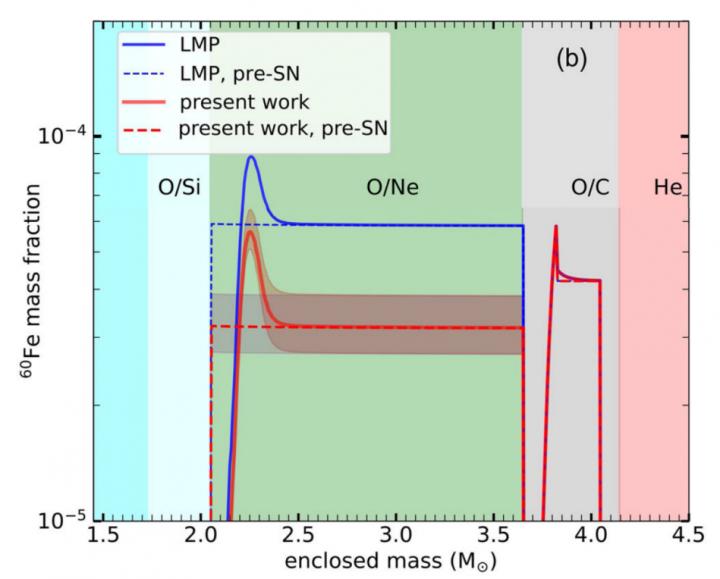
Credit: Physical Review Letters
Researchers from the Institute of Modern Physics (IMP) of the Chinese Academy of Sciences and their collaborators have recently made great progress in the study of the stellar beta-decay rate of 59Fe, which constitutes an important step towards understanding 60Fe nucleosynthesis in massive stars. The results were published in Physical Review Letters on April 12.
Radioactive nuclide 60Fe plays an essential role in nuclear astrophysical studies. It is synthesized in massive stars by successive neutron captures on a stable nucleus of 58Fe and, during the late stages of stellar evolution, ejected into space via a core-collapse supernova.
The characteristic gamma lines associated with the decay of 60Fe have been detected by space gamma-ray detectors. By comparing the 60Fe gamma-ray flux to that from 26Al, which shares a similar origin as 60Fe, researchers should be able to obtain important information on nucleosynthesis and stellar models. However, the observed gamma-ray flux ratio 26Al/60Fe does not match theoretical predictions due to uncertainties in both stellar models and nuclear data inputs.
The stellar beta-decay rate of 59Fe is among the greatest uncertainties in nuclear data inputs. During the nucleosynthesis of 60Fe in massive stars, 59Fe can either capture a neutron to produce 60Fe or beta decay to 59Co. Therefore, the stellar beta-decay rate of 59Fe is critical to the yield of 60Fe.
Although the decay rate of 59Fe has been accurately measured in laboratories, its decay rate may be significantly enhanced in stellar environments due to contributions from its excited states. However, direct measurement of the beta-decay rate from excited states is very challenging since one has to create a high-temperature environment as in stars to keep the 59Fe nuclei in their excited states.
To address this problem, researchers at IMP proposed a new method for measuring the stellar beta-decay rate of 59Fe. “The nuclear charge-exchange reaction is an indirect measurement alternative, which provides key nuclear structure information that can determine those decay rates.” said GAO Bingshui, a researcher at IMP.
The researchers carried out their experiment at the Coupled Cyclotron Facility at Michigan State University. In the experiment, a secondary triton beam produced by the cyclotrons was used to bombard a 59Co target. Then the reaction products, 3He particles and gamma rays, were detected by the S800 spectrometer and GRETINA gamma-ray detection array. Using this information, the beta-decay rates from the 59Fe excited states were determined. This measurement thus eliminated one of the major nuclear uncertainties in predicting the yield of 60Fe.
By comparing stellar model calculations using the new decay rate data with previous calculations, the researchers found that, for an 18 solar mass star, the yield of 60Fe is 40% less when using the new data. The result points to a reduced tension in the discrepancy in 26Al/60Fe ratios between theoretical predictions and observations.
“It is an important step towards understanding 60Fe nucleosynthesis in massive stars and it will provide a more solid basis for future astrophysical simulations,” said LI Kuoang, the collaborator of Gao.
###
This work was supported by the National Key Research and Development program and the Strategic Priority Research Program of CAS.
Media Contact
LIU Fang
[email protected]
Related Journal Article
http://dx.




